Content is from Kirkbride et al. 2006Kirkbride et al. 2006:
Kirkbride JH, Jr, Gunn CR, and Dallwitz MJ. 2006. Family guide for fruits and seeds, vers. 1.0. Accessed September 2020-January 2022. URL: https://nt.ars-grin.gov/seedsfruits/keys/frsdfam/index.cfm ., without modification.
Updates are forthcoming.
Fruits: Pistil(s) 1; 1-pistillate. Fruit anthocarpanthocarp:
simple or compound and including some tissue of non-ovarian origin (accessory tissue)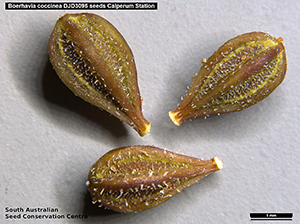 ; simple; cypselacypsela:
; simple; cypselacypsela:
dry, indehiscent, unilocular fruit with a single seed not adnate to the pericarp, similar to an achene but developed from an inferior ovary. Fruit type of Asteraceae.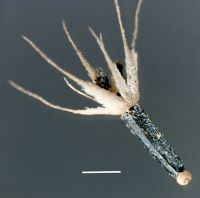 ; without persistent central column; within accessory organ(s), or not within accessory organ(s) (see Notes); within involucreinvolucre:
; without persistent central column; within accessory organ(s), or not within accessory organ(s) (see Notes); within involucreinvolucre:
in the grasses, a whorl or cluster of bracts or bristles subtending a floret or spikelet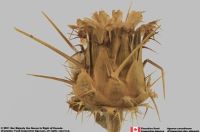 (including 5 long awned calyxcalyx:
(including 5 long awned calyxcalyx:
the outer whorl of the perianth; all the sepals of a flower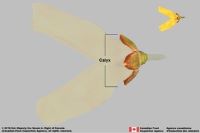 lobes), or calyxcalyx:
lobes), or calyxcalyx:
the outer whorl of the perianth; all the sepals of a flower (epicalyx may also be present; see Notes); accrescentaccrescent:
(epicalyx may also be present; see Notes); accrescentaccrescent:
growing continuously
; persistent; soft calyxcalyx:
the outer whorl of the perianth; all the sepals of a flower ; 1-seeded; 1-seeded; less than 1 cm long; 0.3 cm long (at least); with 1-carpellate; in transection tereteterete:
; 1-seeded; 1-seeded; less than 1 cm long; 0.3 cm long (at least); with 1-carpellate; in transection tereteterete:
approximately circular in cross section; width and thickness approximately equal
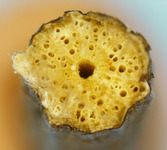 ; apexapex:
; apexapex:
the point farthest from the point of attachment, or the "tip" of an organ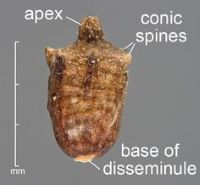 not beaked; indehiscentindehiscent:
not beaked; indehiscentindehiscent:
not opening on its own, as in a fruit
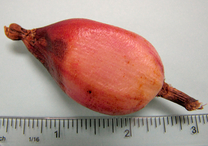 . Epicarpepicarp:
. Epicarpepicarp:
outer layer of fruit wall or pericarp, if divided into layers; note here used synonymously with exocarp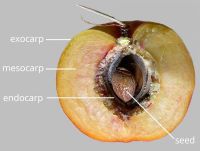 brown (all shades) (at least); durable; glabrousglabrous:
brown (all shades) (at least); durable; glabrousglabrous:
without hairs
; without armature; without wing(s); without apicalapical:
at or pertaining to the end of the seed or fruit distal from its point of attachment (i.e., base)
respiratory hole. Mesocarpmesocarp:
the middle layer of the pericarp, if divided into layers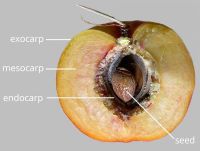 absent. Endocarpendocarp:
absent. Endocarpendocarp:
the inner layer of the pericarp, if divided into layers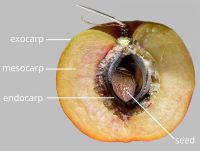 present; not separating from exocarpexocarp:
present; not separating from exocarpexocarp:
outer layer of fruit wall or pericarp, if divided into layers; note here used synonymously with epicarp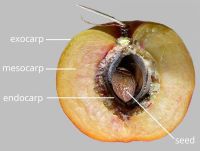 ; thin; not splitting into 1-seeded pyrenes; smooth; without wing; without operculumoperculum:
; thin; not splitting into 1-seeded pyrenes; smooth; without wing; without operculumoperculum:
a dehiscent cap (or lid) of a seed or fruit that opens during germination or dehiscence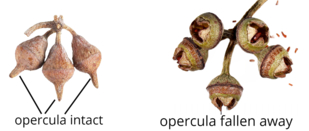 ; without secretory cavities; without mechanism for seedling escape; without grooves; without longitudinallongitudinal:
; without secretory cavities; without mechanism for seedling escape; without grooves; without longitudinallongitudinal:
of or relating to length or the lengthwise dimension
ridges. Funiculusfuniculus:
(alt. funicle) stalk connecting the ovule (later seed) to the ovary (later fruit) placenta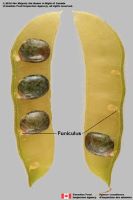 short; short without seed bearing hookswith hooks:
short; short without seed bearing hookswith hooks:
bristles or spines with curved or backwards pointing tips, or with secondary bristles along their length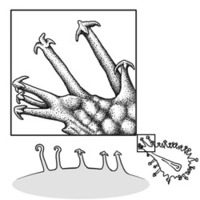 (retinacula); not persisting in fruit after seed shed.
(retinacula); not persisting in fruit after seed shed.
Seeds: Arilaril:
(broad sense) appendicular structure that wholly or partly envelops a seed and is produced from or a modification of the funicle, raphe, or outer integument; usually fleshy or pulpy, sometimes spongy or tufted-capillate, often brightly colored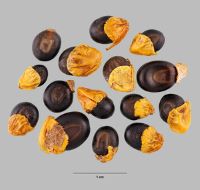 absent. Seed straight; in transection tereteterete:
absent. Seed straight; in transection tereteterete:
approximately circular in cross section; width and thickness approximately equal
 ; not bowl shaped; not nutlike; without winglike beakbeak:
; not bowl shaped; not nutlike; without winglike beakbeak:
a usually firm, terminal appendage, sometimes tapered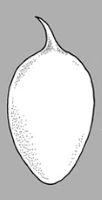 ; without caudatecaudate:
; without caudatecaudate:
tapering to a long, tail-like appendage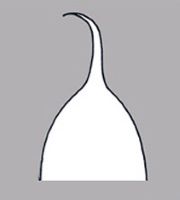 appendage(s); at maturity with food reserves; with endosperm; without canavanine. Sarcotestasarcotesta:
appendage(s); at maturity with food reserves; with endosperm; without canavanine. Sarcotestasarcotesta:
pulpy or fleshy outer layer of the seed coat, simulates aril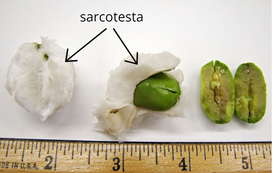 absent. Testatesta:
absent. Testatesta:
seed coat
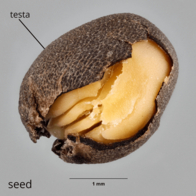 present (but hardly separable from pericarppericarp:
present (but hardly separable from pericarppericarp:
fruit wall or fruit coat
), or absent; without embryo surrounded and capped by viscid tissue; without markedly different marginalmarginal:
at, on, or close to the margin or border
tissue; without fleshy or leatheryleathery:
texture—moderately thick, tough, and very pliable
layer over hard layer; tight; without crease or line separating cotyledons from hypocotyl-radicle; without notch along margin where cotyledons from hypocotyl-radicle tip approach each other; without glands; without bristles; glabrousglabrous:
without hairs
; without wings; without collar; without operculumoperculum:
a dehiscent cap (or lid) of a seed or fruit that opens during germination or dehiscence ; colored; monochrome; membranousmembranous:
; colored; monochrome; membranousmembranous:
texture—extremely thin, pliable, and fairly tough
; not becoming mucilaginousmucilaginous:
resembling mucilage; moist and sticky
when wetted; surrounding food reserve. Endosperm development cellular; scant, or moderate; fleshy; opaqueopaque:
not transmitting light
; smooth; without starch; with oils; without fatty acid containing cyclopropene; without apicalapical:
at or pertaining to the end of the seed or fruit distal from its point of attachment (i.e., base)
lobes; without chlorophyll; without isodiametric faceted surface; without odor. Embryo differentiated from food reserve; well developed; 1 per seed; partially filling testatesta:
seed coat
 (with food reserve), or nearly filling testatesta:
(with food reserve), or nearly filling testatesta:
seed coat
 (trace or scanty food reserve); 0.9 times the length of food reserve; at one end of seed not extending into a depression or cup; axileaxile:
(trace or scanty food reserve); 0.9 times the length of food reserve; at one end of seed not extending into a depression or cup; axileaxile:
on or of the axis
and centric; foliatefoliate:
appearing leaf-like
; with spatulatespatulate:
2D shape—like a spatula; rounded at the apex, with base long and tapered; (of embryo) embryo is straight and axile and centric with the cotyledons expanded to form the shape of a spatula or spoon; (of cotyledons) cotyledons expanded and wider than the stalk but not invested into the stalk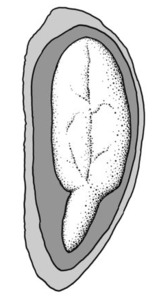 cotyledons; straight; parallel to seed length; embedded in endosperm; with cotyledons gradually connected to hypocotyl-radicle; without coleorhiza; without simmondsin; without stomata; not green; with 2 or more cotyledons. Cotyledons 2; moderately developed, or well developed; 0.35–0.9 times length of embryo; somewhat to significantly wider than hypocotyl-radicle; 1.7–4 times wider than hypocotyl-radicle; not concealing hypocotyl-radicle; not foliaceous; thin, or thick; flat; smooth; with apicesapex:
cotyledons; straight; parallel to seed length; embedded in endosperm; with cotyledons gradually connected to hypocotyl-radicle; without coleorhiza; without simmondsin; without stomata; not green; with 2 or more cotyledons. Cotyledons 2; moderately developed, or well developed; 0.35–0.9 times length of embryo; somewhat to significantly wider than hypocotyl-radicle; 1.7–4 times wider than hypocotyl-radicle; not concealing hypocotyl-radicle; not foliaceous; thin, or thick; flat; smooth; with apicesapex:
the point farthest from the point of attachment, or the "tip" of an organ entire; with margins separate; basally entire; equal in size; not punctatepunctate:
entire; with margins separate; basally entire; equal in size; not punctatepunctate:
surface relief—dotted with pits or with translucent, sunken glands or with colored dots, similar to pitted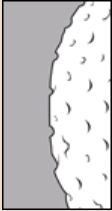 dotted. Hypocotyl-radicle small to well developed; straight; not thickened.
dotted. Hypocotyl-radicle small to well developed; straight; not thickened.
Noxious weeds: 1 or more USA state noxious weeds in this family.
USA states and territories with listed noxious weeds: Colorado (CO), Iowa (IA), New Mexico (NM), and Oregon (OR).
USA state and territory noxious weeds:
Dipsacus fullonum L.: USA state noxious weed: CO●, NM●.
Dipsacus laciniatus L.: USA state noxious weed: CO●, OR●.
Dipsacus spp.: USA state noxious weed: IA●.
Symbols: ªaquatic weed; ●terrestrial weed; °weed in seed.
Last updated February 2006.
Scored similarly to Morinaceae. True fruit is an acheneachene:
a dry, indehiscent, one-seeded fruit, with seed attached to pericarp at a single point, derived from a single, superior, simple or compound, one-loculed ovary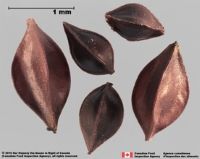 within an involucreinvolucre:
within an involucreinvolucre:
in the grasses, a whorl or cluster of bracts or bristles subtending a floret or spikelet = capsela. Mabberley recognized D. & Morinaceae. Cronquist: "Fruit an acheneachene:
= capsela. Mabberley recognized D. & Morinaceae. Cronquist: "Fruit an acheneachene:
a dry, indehiscent, one-seeded fruit, with seed attached to pericarp at a single point, derived from a single, superior, simple or compound, one-loculed ovary , enclosed (except at the top) by the epicalyx and commonly crowned by the persistent calyxcalyx:
, enclosed (except at the top) by the epicalyx and commonly crowned by the persistent calyxcalyx:
the outer whorl of the perianth; all the sepals of a flower ". The epicalyx is illustrated in Devesa's (1984) Fig. 1 by Devesa (1984).
". The epicalyx is illustrated in Devesa's (1984) Fig. 1 by Devesa (1984).
Literature specific to this family: Gonzalez, G.L. 1981. Pterocepalidium, un nuevo género Ibérico de la familia Dipsacaceae. Anales Jard. Bot. Madrid 43:245–252; Devesa, J.A. 1984. Pseudoscabiosa, génera nuevo de Dipsacaceae. Lagascalia 12:213–221.
General references: Baillon, H.E. 1866–95. Histoire des plantes, 13 vols. Hachette & Co., Paris, Corner, E.J.H. 1976. The seeds of Dicots, esp. vol. 2. Cambridge University Press, New York, Cronquist, A. 1981. An integrated system of classification of flowering plants, 1,262 p. Columbia University Press, New York, Engler, A. & K. Prantl. 1924 and onward. Die Natürlichen Pflanzenfamilimien. W. Engelman, Leipzig, Gaertner, J. 1788–1805. De fructibus et seminibus plantarum. The Author, Stuttgart, Goldberg, A. 1986 (dicots) & 1989 (monocots). Classification, evolution, and phylogeny of the familes of Dicotyledons. Smithsonian Contr. Bot. 58 for dicots (314 pp.) & 71 for monocots (74 pp.). [Goldberg's illustrations are reproduced from older publications and these should be consulted], Gunn, C.R. & C.A. Ritchie. 1988. Identification of disseminulesdisseminule:
detachable plant part capable of being disseminated and of propagating, commonly a seed or fruit
listed in the Federal Noxious Weed Act. Techn. Bull. U.S.D.A. 1719:1–313, Gunn, C.R., J.H. Wiersema, C.A. Ritchie, & J.H. Kirkbride, Jr. 1992 & amendments. Families and genera of Spermatophytes recognized by the Agricultural Research Service. Techn. Bull. U.S.D.A. 1796:1–500, Hooker, J.D. 1873 and forward. Icones Plantarum. William & Norgate, London. (plate number cited in text within [ ]), LeMaout, E. & J. Decaisne. 1876. A general system of botany, 1,065 p. Longmans, Green, & Co., London, Mabberley, D.J. 1987. The plant-book, 706 p. Cambridge University Press, Cambridge, Martin, A.C. 1946. The comparative internal morphology of seeds. Amer. Midl. Naturalist 36:513–660, and Spjut, R.W. 1994. A systematic treatment of fruit types. Mem. New York Bot. Gard. 70:1–182.